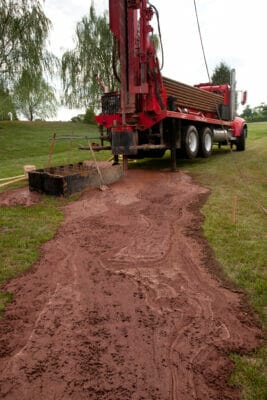Disclaimer: This post may contain affiliate links, meaning we get a small commission if you make a purchase through our links, at no cost to you. For more information, please visit our Disclaimer Page.
A drilled well can collapse. This can be caused by either damaged or corroded well casing and screens, or excessive water velocity flowing into the well causing formation particles such as sand. These particles flow into the well, eventually leading to the collapse of a well’s wall.

Table of Contents
Is A Drilled Well Safe?
A drilled well is safer compared to other types of wells. This is because a drilled well is constructed with high-quality materials that not only guarantee its safety but also keep the water safe for consumption.
Unlike dug wells, drilled wells can go up to more than 1000 feet deep. This means there could be possibilities of contaminants such as chemicals or mineral additives present due to drilled wells. So, to ensure its safety, drilled wells are constructed with screens and casing.
These materials ensure that there is no influx of sediments and other particles or immediate collapse of the well. This means drilled wells are less susceptible to contamination. However, certain measures should be taken to enhance well safety.
You can also stop possible contamination of a drilled well by draining off the water starting from the surface down around the side of the casing. Also, you can keep the well safe and clean by sealing the space around the casing.
Can a Drilled Well Collapse?
Even though a drilled well can last longer due to the high-quality materials used to build it, the well can still collapse. This is because, with time, corrosion occurs to the materials — casing, and screens, thus causing damage.
Due to this damage, excessive water velocity will find its way into the well causing formation particles such as moving sand and silt. These particles in turn flow into the well, leading to a collapse of the drilled well.
A drilled well can also collapse due to an improper well design. When drilling or designing a well, certain critical decisions must be made to guarantee its durability and safety.
This includes perforated well liner and well screen, slot size of well screen, the size and amount of sand pack around the well screen, and the location of the pump in the well.
If these considerations are not put in place, the well might collapse due to sediments in the water or reduce well yield.
Additionally, drilled wells can collapse due to mineral incrustation. This means an abundance of dissolved minerals such as calcium, magnesium, and iron form around some shallow water table aquifers.
And so, due to the changes in pressure and temperature whenever water is pumped from the well, these minerals precipitate or settle out, thus causing scale formation on the slotted casing, liner, and screens.
How Do You Know if Your Well is Collapsing?
You will know that your well is collapsing if you start to notice the following signs:
A lot of sand or a large number of sediments from the well
We have already seen that the presence of sand is not good since it wears out the pump valve, thus filling up the well’s bottom with sand. Therefore, if your well is pumping silt or a large number of sediments, then you should know that the well has started to collapse.
This common sign means that the well screens have deteriorated. Degraded well screens will allow sand or sediments in from the gravel pack around it.
Water Pressure is Low
Another sign that your well is collapsing is that you will start to experience no water from the well.
This can be caused by many reasons ranging from a failing well pump, partially closed or stuck valve to iron bacteria clogging up the pipe nipple towards the pressure switch. When this happens, the pressure switch will sense pressure incorrectly.
However, you can prevent your well from collapsing in this manner by cleaning it with a special solution designed to remove iron bacteria.
Changes in Water Quality
Changes in water quality such as odor, sand, or sediments are an indication that something has happened to your well shaft, casing, drop pipe, or pump. It can also mean that surface water is penetrating into the well.
You can always get your water tested in case of a sudden change in your well’s water quality.
The Well is Pumping Air
Your well is collapsing when the well’s pump drop pipe either breaks apart, is corroded, or develops cracks, allowing air to be sucked in. when this happens, you will realize out blasts of a mixture of air and water whenever you turn on your kitchen faucet.
And the worst part is that sometimes the pump will draw in the air during the pump cycle.
Water Sputtering out of the Tap
Water sputtering out of the tap can be an indication that your well is collapsing. Sometimes underground water tables may contain different types of gasses such as carbon dioxide, methane, hydrogen sulfide, or other gasses.
When these gasses are dissolved in water, they usually come out as a solution, triggering water to sputter out of the tap.
High Electricity Bill
A general result of all the above signs of a collapsing well is that you will begin to experience an increasingly higher power cost.
For instance, if the well’s check valve goes bad, allows water from the pressure tank to stream back down into the well. This may create an on and off-cycle occurring every few minutes, allowing the pump to run practically for 24 hours a day.

How Do You Fix a Collapsed Well?
Depending on the course of action, you can either choose to fix a collapsed well yourself or seek out the help of a professional contractor. For example, minor leaks can be handled by DIYer while major problems such as a collapsed well casing can be done by a contractor.
To fix a collapsed well casing, first identify where the collapsed area is located then develop it. For this case, it is probably the area below the casing.
To develop the area, jet a large amount of high-pressure water into the well. The water will disturb the sediment that has been collected in the bottom of the well and cause it to be suspended in the water.
Remove all the sediments containing water out of the well into the truck and dispose of it elsewhere.
Since the sediments have been removed from the collapsed well, extra space for water will be created. You don’t need to worry about fine sediments since can no longer contaminate your well water.
However, jetting the well might not work properly in case there is heavy sediment such as large pieces of bedrock at the bottom of the well. So, in this case, it is important for the well service to drill the well deeper in order to make extra space for water to collect.
On the other hand, if the collapsed well is due to a minor leakage, you can fix it using a repair sleeve or well liner then ask the contractor to seal it to make sure it holds. This tool is compatible to fit in the casing without causing any disruption.
